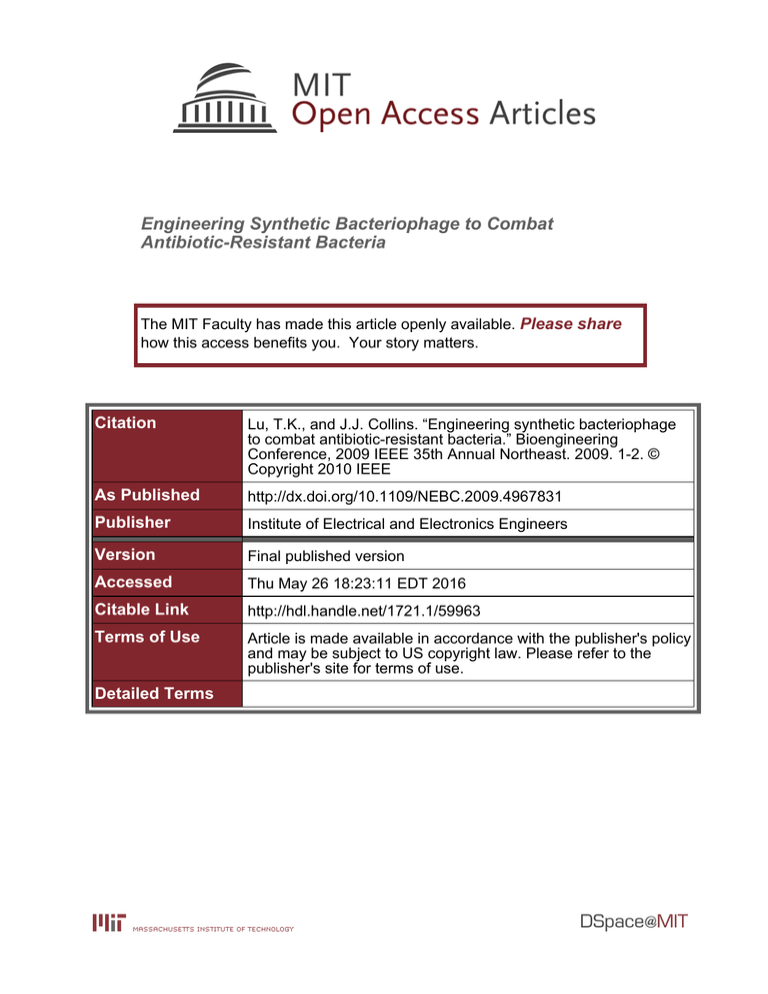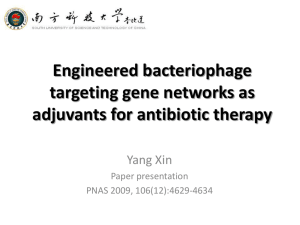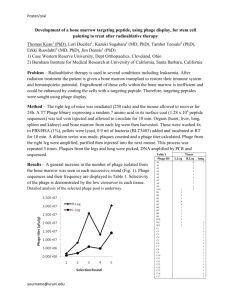Engineering Synthetic Bacteriophage to Combat Antibiotic-Resistant Bacteria Please share
advertisement

Engineering Synthetic Bacteriophage to Combat Antibiotic-Resistant Bacteria The MIT Faculty has made this article openly available. Please share how this access benefits you. Your story matters. Citation Lu, T.K., and J.J. Collins. “Engineering synthetic bacteriophage to combat antibiotic-resistant bacteria.” Bioengineering Conference, 2009 IEEE 35th Annual Northeast. 2009. 1-2. © Copyright 2010 IEEE As Published http://dx.doi.org/10.1109/NEBC.2009.4967831 Publisher Institute of Electrical and Electronics Engineers Version Final published version Accessed Thu May 26 18:23:11 EDT 2016 Citable Link http://hdl.handle.net/1721.1/59963 Terms of Use Article is made available in accordance with the publisher's policy and may be subject to US copyright law. Please refer to the publisher's site for terms of use. Detailed Terms Engineering Synthetic Bacteriophage to Combat Antibiotic-Resistant Bacteria T.K. Lu"t and J.J. Collinst 'Harvard-MIT Division of Health Sciences and Technology, 77 Massachusetts Ave., E25-5I9, Cambridge, MA 02139 tHoward Hughes Medical Institute, Center for BioDynamics and Department of Biomedical Engineering, Boston University, 44 Cummington Street, Boston, MA 02215 Abstract-Antibiotic resistance is a rapidly evolving problem that is not being adequately met by new antimicrobial drugs. Thus, there is a pressing need for effective antibacterial therapies that can be adapted against antibiotic-resistant bacteria. Here, we engineered synthetic bacteriophage to combat antibiotic-resistant bacteria by overexpressing proteins and attacking gene networks which are not directly targeted by antibiotics. By suppressing the SOS network, our engineered phage enhance bacterial killing by quinolone antibiotics by several orders of magnitude in vitro and significantly increase the survival of infected mice in vivo. Our synthetic phage design can be extended to target non-SOS gene networks and overexpress multiple factors to produce additional effective antibiotic adjuvants. In addition, our synthetic phage act as strong adjuvants for other bactericidal antibiotics, improve the killing of antibiotic-resistant bacteria, and reduce the number of antibiotic-resistant bacteria that arise from antibiotic-treated populations. This work establishes a novel synthetic biology platform for translating identified targets into effective antibiotic adjuvants. protein, and lipid damage, and ultimately, cell death [2]. DNA damage initiates the SOS response [9], which results in DNA repair and cell survival (Fig. IA). To suppress the SOS network and enhance the effect of bactericidal antibiotics, we engineered M13mpI8 phage to overexpress lexA3, a repressor of SOS [10]; we named this phage <j>lexA3 (Fig. IA) and the unmodified M13mpI8 phage <j>urunod' M13mpI8, a modified version of M13 phage, is a non-lytic filamentous phage and can accommodate DNA insertions into its genome [11]. A Antlblotlca Enhonced cen o..lh I. INTRODUCTION Bacterial infections are responsible for significant morbidity and mortality in clinical settings [1]. Dramatic increases in antibiotic-resistant infections are responsible for sicker patients, longer hospitalizations, and increased costs [1]. New classes of antimicrobials are needed, but few are in pharmaceutical pipelines [1]. High-throughput systems biology studies have enabled the discovery of many potential drug targets [2, 3], but a significant amount of additional work and investment is needed to translate these targets into actual drugs. Moreover, antibiotic drugs typically do not take advantage of targets that need to be upregulated in order to achieve antimicrobial activity. Thus, there is a significant gap between target identification and drug development. Natural phage have been used to kill bacteria since the early 20 th century [4]. We engineered antibiotic-adjuvant phage to overexpress proteins to target non-essential gene networks that are not directly attacked by antibiotics in order to minimize evolutionary pressures. By using a combination of engineered phage and antibiotics, we reduce the evolution of antibiotic resistance and enhance bacterial killing [5-8]. II. TARGETING THE SOS DNA REPAIR SYSTEM Bactericidal antibiotics (e.g., quinolones such as ofloxacin) induce the formation of hydroxyl radicals which cause DNA, Fig. l. Engineered </llexA3 phage enhances killing of wild-type E. coli EMG2 bacteria by bactericidal antibiotics. (A) Engineered phage, with the lexA3 gene (</llexA3) under the control of a promoter (PLtetO) and a ribosome-binding sequence (RBS) (12), act as antibiotic adjuvants by suppressing SOS and increasing cell death. (8) Killing curves for no phage (black diamonds), unmodified phage </lunmod (red squares), and engineered phage </llexA3 (blue circles) with 60 nglmL ofloxacin [oflox) (solid lines, closed symbols). 108 plaque-forming-units/mL (PFU/mL) phage was used. A growth curve for EMG2 with no treatment is also shown (dotted line, open symbols). </llexA3 greatly enhanced killing by ofloxacin by 4 hours of treatment. To test <j>lexA/S antibiotic-enhancing effect, we obtained time courses for killing of E. coli EMG2 bacteria with phage and/or ofloxacin treatment. We calculated viable cell counts by counting colony-forming units (CFUs) during treatment (Fig. IB). After 6 hours, bacteria exposed to ofloxacin only were reduced by about 1.7 10glO(CFU/mL), reflecting the presence of persister cells not killed by the drug (Fig. IB). By 6 hours, <j>lexA3 improved ofloxacin's bactericidal effect by 2.7 orders of magnitude compared to unmodified phage <j>urunod (-99.8% additional killing) and by over 4.5 orders of magnitude compared to no phage (-99.998% additional killing) (Fig. IB). With combination phage and antibiotic treatment, no significant bacterial regrowth was apparent (Fig. IB). We also tested our synthetic phage along with other classes of bactericidal antibiotics, including gentamicin, an aminoglycoside, and ampicillin, a ~-lactam. <j>lexA3 increased This work was supported by the National Institutes of Health through the NIH Director's Pioneer Award Program, grant number DPI 00003644, the NSF FIBR Program, and the Howard Hughes Medical Institute. T.K.L. was supported by a Howard Hughes Medical Institute Predoctoral Fellowship and a HarvardlMIT Health Sciences and Technology Medical EngineeringlMedical Physics Fellowship. gentamicin's bactericidal action by over 2.5 and 3 orders of magnitude compared with </>urunod and no phage, respectively. </>lexA3 improved ampicillin's bactericidal effect by over 2 and 5.5 orders of magnitude compared with </>urunod and no phage, respectively. For both gentamicin and ampicillin, </>lexA/S strong adjuvant effect was noticeable after 1 hour of treatment. These results show that engineered phage can act as adjuvants for the three major classes of bactericidal drugs. Using this design, we have also created synthetic phage that target non-SOS genetic networks and/or overexpress multiple factors and have shown that they act as effective antibiotic adjuvants [13]. III. KILLING ANTIBIOTIC-RESISTANT BACTERIA In addition to enhancing the killing of wild-type bacteria, engineered phage can improve the killing of bacteria that have already acquired antibiotic resistance and may therefore have the potential to revive defunct antibiotics. We applied </>lexA3 with ofloxacin against E. coli RFS289, which carries a gyrAlll mutation that renders it resistant to quinolones. </>lexA3 increased bacterial killing by ofloxacin by over 2 and 3.5 orders of magnitude compared with </>urunod and no phage, respectively. Furthermore, we have shown that synthetic phage significantly reduce the number of antibiotic-resistant bacteria that evolve from antibiotic-treated populations [13]. IV. RESCUING MICE INFECTED WITH BACTERIA lhpoo1__ rv 1J"Ntrnen wtth: ~ .._ unmod :a.!' : 1 (2) (4) (5) (6) (8) 6 - - -- ~ '0 20IE~~·~,:::~:::::--~·;;::_J·IL,- 1=1- ::: 00 (9) -+-- +--< 10 - - - - . - - - - 0 ----. (10) 2 3 Treatment time (d) Fig. 2 Engineered </l[e>:AJ phage increases survival of mice infected with bacteria. (A) Female Charles River CD-I mice were inoculated with 8.8 * 10' CFU/mouse E. coli EMG2. Treatments included 0.2 mg/kg ofloxacin and/or 109 PFUlmouse phage as indicated. Deaths were recorded at the end of each day. The mouse drawing was used under a Creative Commons Attribution 2.5 License [14]. (B) Survival curves for infected mice show that engineered phage </l[e>:AJ plus ofloxacin (solid line, closed blue circles) significantly increases survival compared with unmodified phage </lunmod plus ofloxacin (solid line, closed red squares), no phage plus ofloxacin (solid line, closed black diamonds), and no treatment (dashed line, open black diamonds). V. [I) (7) ~ +,IuAl +oftox REFERENCES (3) To demonstrate the clinical efficacy of antibiotic-enhancing phage in vivo, we applied our engineered phage with ofloxacin to prevent death in mice infected with bacteria (Fig. 2). Mice were injected with E. coli intraperitoneally 1 hour prior to receiving intravenous treatments (Fig. 2A). Eighty percent of mice treated with </>lexA3 plus ofloxacin survived, compared with 50% and 20% for mice that received </>urunod plus ofloxacin or ofloxacin alone, respectively (Fig. 2B). ¥f:~}- solve important real-world biomedical problems. Synthetic biology is focused on the rational and modular engineering of organisms to create novel behaviors. Synthetic phage are well-suited for incorporating targets, identified via systems biology, in a modular fashion to create effective antibiotic adjuvants. With current DNA sequencing and synthesis technologies, an entire engineered phage genome carrying multiple constructs that target different gene networks could be synthesized for less than $10,000 [15]. These everimproving technologies will enable large-scale modifications of phage libraries to produce antibiotic-adjuvant phage that target different gene networks and that can be applied with different antibiotic drugs against a wide range of bacteria. Our in vitro and in vivo work demonstrates that synthetic phage can be engineered to act as effective antibiotic adjuvants and may help close the gap between antimicrobial target identification and implementation. Thus, combination therapy which couples antibiotics with engineered antibioticadjuvant phage is a promising antimicrobial strategy for the future. CONCLUSIONS Our phage platform enables the development of effective antibiotic adjuvants and is a practical example of how synthetic biology and systems biology can be applied to [II) [I 2) [I3) (14) [15) C. Walsh, " Where will new antibiotics come from?," Nat Rev Microbiol, vol. I, no. I, pp. 65-70, Oct, 2003. M. A. Kohanski, D. J. Dwyer, B. Hayete et al., "A common mechanism of cellular death induced by bactericidal antibiotics," Cell, vol. 130, no. 5, pp. 797-810, Sep, 2007. M. A. Kohanski, D. J. Dwyer, J. Wierzbowski et al., "Mistranslation of membrane proteins and two-component system activation trigger antibiotic-mediated cell death," Cell, vol. 135, no. 4, pp. 679-90, Nov 14, 2008. C. R. Merril, D. Scholl, and S. L. Adhya, "The prospect for bacteriophage therapy in Western medicine," Nat Rev Drug Discov, vol. 2, no. 6, pp. 489-497, Jun, 2003. T. K. Lu, and J. J. Collins, "Dispersing biofilms with engineered enzymatic bacteriophage," Proc Nat! Acad Sci USA , vol. 104, no. 27, pp. 11197-11202, Jul, 2007. R. Chait, A. Craney, and R. Kishony, "Antibiotic interactions that select against resistance," Nature, vol. 446, no. 7136, pp. 668-671 , Apr, 2007. S. B. Levy, and B. Marshall, "Antibacterial resistance worldwide: causes, challenges and responses," Nat Med, vol. 10, no. 12 Suppl, pp. SI22-SI29, Dec, 2004. S. Hagens, A. Habel, and U. Blasi, "Augmentation of the antimicrobial efficacy of antibiotics by filamentous phage," Microb Drug Resist, vol. 12, no. 3, pp. 164-168, 2006. C. S. Lewin, B. M. Howard, N. T. Ratcliffe et al., "4-quinolones and the SOS response," J Med Microbiol, vol. 29, no. 2, pp. 139-144, Jun, 1989. J. W. Little, and J. E. Harper, "Identification of the lexA gene product of Escherichia coli K-12," Proc Natl Acad Sci USA , vol. 76, no. 12, pp. 6147-6151 , Dec, 1979. C. Yanisch-Perron, J. Vieira, and J. Messing, "Improved M13 phage cloning vectors and host strains: nucleotide sequences of the M13mpl8 and pUCI9 vectors," Gene, vol. 33, no. I, pp. 103-119, 1985. R. Lutz, and H. Bujard, "Independent and tight regulation of transcriptional units in Escherichia coli via the LacRlO, the TetRiO and AraC/IJ-I2 regulatory elements," Nucleic Acids Res, vol. 25, no. 6, pp. 1203-1210, Mar, 1997. T. K. Lu, and J. J. Collins, "Engineered bacteriophage targeting gene networks as adjuvants for antibiotic therapy," Proc Nat! Acad Sci USA , under review. J. B. Stewart, C. Freyer, J. L. Elson et al., "Strong purifying selection in transmission of mammalian mitochondrial DNA," PLoS Bioi, vol. 6, no. I, pp. elO, Jan, 2008. D. Baker, G. Church, J. Collins et al. , "Engineering life: building a fab for biology," Sci Am, vol. 294, no. 6, pp. 44-51 , Jun, 2006.







